Aluminum, Eco-Boosted F-150 Rewrites Rules
Filed under: Equinox, Autos
By John Gilbert
After driving the revolutionary 2015 Ford F-150 pickup truck at its introduction in the Texas Hill Country west of San Antonio, I knew I would need more. Such as, the opportunity to try various models of the F-150 on my “home turf” in Northern Minnesota to get the true feeling of the new truck’s significance.
Several SuperCrew versions, with the two most-powerful engines, worked well during fall, winter and spring sessions, then I finally got an F-150 almost the way I would order one: The SuperCab, with the new 2.7-liter EcoBoost V6.
My theory always has been anything bigger than big enough is too big, and there’s no advantage to hauling extra weight around, losing fuel economy, and finding parking spots for lengthier models.
Going with the lighter theme, the new 2.7 member of Ford’s EcoBoost family is unrelated to the 3.5, which began life built to withstand the fast-revving forces of turbocharging. Ford enlarged it to 3.7, then brought it back to 3.5 this year.
The concept of downsizing in number of cylinders and displacement size is to gain fuel economy, and jacking up the power with turbocharging bridges any gap to provide better towing and hauling numbers than the trusty and traditional V8s. The 3.5 EcoBoost proves it, with increases of over 80 horses and about 130 foot-pounds by adding the turbos.
All versions of the new F-150 seem to reflect the broader base and stronger framework of the pickup, as well as improved suspension and maybe the lighter weight. The trucks feel stable and planted on the highway, and they carve into curves smoothly with the well-balanced power steering, with the standard 6-speed automatics handling the power assortment.
When I first got the 2.7 EcoBoost-powered model, I mentioned to my wife, Joan, that it must be the most powerful engine, because of the way it dashed up some steep hillsides in Duluth. When I got home and unfolded the information sheet, I was surprised and impressed to learn it was the smallest 2.7, performing with potency because of the twin turbos, and with what felt like added agility from the smaller cab and lighter weight.
I also was able to coax 23 miles per gallon from the 2.7, but you have to be careful — take it easy on the hot starts and go light on the gas and you can get mid-20s, but if you kick it down to enjoy the potential of the turbos, you will drop quickly to 20 or less.
The test vehicles varied in price as much as in style and equipment. Figure if you’re going to get the trailer-towing package, spray-in bed-liner, the latest Sync connectivity, and a few other options, you’re going to be up over $40,000 in a hurry, and probably over $50,000.
As has become customary in the full-size pickup business, all the terms stress superlatives, because nobody wants to be assessed as inferior in any way. Ford’s list of names goes from XL to XLT, then up to Lariat — it’s apparently also mandatory to name the top-of-the-line models with some sort of ranch or cowboy euphemism. But wait — there’s more! Above and beyond the Lariat is the King Ranch, and above that is the Platinum, as Ford acknowledges that truck customers are not only willing but eager to pay over $50,000 or $60,000 to get their pickups loaded up with fancy interiors and all sorts of creature features.
There used to be base, extended cab, and crew-cab pickups, and that has advanced from the basic up through various cab sizes, to full, double-length SuperCrew, which installs luxury-sedan features into trucks. The SuperCab sounds big enough, but it’s actually what used to be called extended-cab.
It has a second row seat that is spacious enough to carry passengers, but instead of a huge pair of rear doors, it
has narrow rear doors that open from rear hinges. On my test truck, opening those doors reveals no B pillar separating it from the front doors. The rear seat can fold up, revealing a fair amount of storage space.
And in a trick swiped from Nissan’s Titan, the SuperCab rear doors open 170 degrees, folding back almost flush to the body, which is handy for parking lots and for ease in loading passengers or items.
It was bold for Ford to take the nation’s top-selling vehicle and daringly changed everything. Underpinning the cab with a majority of ultra-high and high-strength steel, Ford went to a body and box of high-grade aluminum. While the switch to aluminum has dominated the news about the 2015 North American Truck of the Year, the addition of a comparatively tiny EcoBoost 2.7-liter V6 engine to power the lightened truck might be almost as significant.
Altogether, the new F-150 comes in about 700 pounds lighter than its predecessor, and while the usual dizzying array of cab configurations and box lengths are available, the powertrains provide big power in smaller packages as they fly in the face of the Chevrolet, GMC, Ram and Toyota competitors and their huge V8s.
The biggest Ford engine a year ago was the 6.2-liter V8, and it no longer is available. Biggest now is the Mustang-based 5.0 V8 which has a wonderful audible report to being stomped on. The 2.7 is the wild-card added to Ford’s array, which ranges from the naturally-aspirated base 3.5-liter V6, with 283 horsepower and 255 foot-pounds of torque; then a large step up to the 3.5 EcoBoost, twin-turbocharged up to 365 horsepower and 420 foot-pounds of torque; and the 5.0-liter V8, with 385 horsepower and 387 foot-pounds.
Augmenting that trio, the all-new 2.7-liter V6 also gets the EcoBoost treatment, which includes direct injection and twin turbochargers, and it generates 325 horsepower and 375 foot-pounds of torque. That’s not as much as the 3.5 EcoBoost or the V8, but surprisingly close, and if you try it, it might be enough.
Surprisingly, a lot of publications, columnists, and some voters dismissed the F-150 in Truck of the Year assessments. There are some other impressive trucks, including the new mid-size Chevrolet Colorado and its sister ship GMC Canyon. But the switch to aluminum construction, and the expansion of powertrains to include a smaller and second EcoBoost with amazing power, sets the F-150 on a pedestal by itself.
It won the North American Truck of the Year, and will be the focal point for the next-generation Ram, Silverado, and whatever else is in the segment. The new F-150 has cross-member beams of heavy-duty aluminum bars encircled with high-strength steel.
Steel in vehicle construction can be in a half-dozen different levels of strength, and expense, so Ford used a lot of the lightest and strongest high-grade steel, and the strongest aluminum, to assure the F-150 would be lighter, but also tougher than the very challenging competition. The square structure under the front end, and the “A” pillars are hydro-formed for added strength.
Colleen Hoffman, one of the many engineers focused on the transition, talked about reinforced fenders and important parts beyond the body panels that are both lighter and stronger by the transition to aluminum, allowing the F-150 to come in 700 pounds lighter than the 2014 model.
“Panels are heat-treated for strength, and every component comes out 20 percent lighter, and yet stronger by weight than normal steel,” said Hoffman, explaining the compromises on weight and strength. “Aluminum is more expensive to work with, but it can be down-gauged.”
Three years ago, Ford put the 3.5-liter V6 EcoBoost in the F-150 and proved it could out-accelerate and out-pull its V8s, while also getting improved fuel economy, simply by having two fewer cylinders. Quickly, the EcoBoost 3.5 became the top-selling F-150. This year, the 2.7 is likely to be the top seller. For the top-selling truck.
Refined, Restyled, Sonata Remains Midsize Icon
Filed under: Equinox, Weekly test drives, Autos
By John Gilbert
When Hyundai redesigned its midsize Sonata for the 2011 model year, a trusty and useful caterpillar was transformed into a stunning and award-winning butterfly, and the overall success of the Sonata gave the South Korean company an instant signature vehicle.
Boasting a sketchpadful of curvaceous contours, it also was blessed with new levels of high-grade steel — from its own steel plant — for lightness without compromising safety, and an all-new 2.4-liter 4-cylinder engine that bristled with sporty power, thanks to a futuristic high-pressure/low-temperature but costly direct injection system. Hyundai hooked it up to its own corporate 6-speed automatic transmission that was built in-house and was lighter and smaller than the less-efficient aftermarket 5-speed transmissions used by other companies.
All those features gave the Sonata a technical edge on its competition almost before suddenly the Accord, Camry, Mazda6, Fusion, Malibu and Altima knew that more than midsize room and sportiness were being challenged. Despite the edge in technology and fuel efficiency, the Sonata also came in several thousand dollars lower in sticker price. As if to prove that everything could be star-crossed into one vehicle, the 2011 Sonata was U.S. built, in a new plant in Montgomery, Ala., while its engine plant was 50 miles up the freeway.
I thought the Sonata was the most significant car introduced for 2011, and I mentioned to a Hyundai engineer back then that the car had all the ingredients to be the perfect contemporary vehicle. The only thing lacking, I suggested, was in steering and suspension, both for firmer handling, and also because they could be coordinated for the true sporty handling the car deserved. Those would be the toughest achievements, and take the longest to attain.
Still, self-teaching itself to create the ingredients was substantial enough that Hyundai could spread its new-found technical wealth around to its other vehicles. Within a couple of years, all its smaller 4s, larger V6es, and new V8s benefitted by direct injection and the in-house transmission.
A new entry-luxury Genesis was another part of Hyundai’s upsurge, which is a factor in the new-for-2015 scenario. A thoroughly renovated Genesis has just arrived for 2015, with smoothly flowing refinement and the proper room and features of a luxury sedan, with proper handling, having learned a few suspension tricks from consultation with Lotus engineers. It all works amazing well.
But before anyone could suggest the bargain-luxury Genesis had become Hyundai’s new signature model, the redesigned 2015 Sonata arrived. On the outside, the Sonata trades in the polarizing contours for a more formal look, which Hyundai calls “Fluidic Sculpture.” The new Sonata actually resembles the new Genesis more than it does the outgoing Sonata, leaving those curvy contours to remain distinctive for the 2011-14 Sonata, and replacing them with sweeping lines and a new, upright, Genesis-like grille.
“Instead of adding more flair, we put straighter lines on the sides, so it looks more like an athlete in a tight suit,” said Christopher Chapman, chief designer of the car.
The resemblance is striking if you park a Sonata alongside a Genesis. You could easily mistake one for the other, although the Genesis never looks like a bargain-priced midsize, even if the new Sonata takes on entry-luxury stature. Inside, the Sonata’s interior has been refined and restyled to appeal to every taste. But the real trick is underneath that exterior and interior.
Hyundai will never say that Lotus helped design the suspension of the new Genesis, but from vastly tightened and responsive steering and the far more coordinated suspension of both cars, we can theorize that Hyundai engineers applied some Lotus ideas to the rear-drive Genesis, then reconfigured it to revolutionize the front-wheel-drive Sonata’s feel.
In the corporate scheme of things, Kia gets joint-venture use of Hyundai engines and transmissions. Kia builds the Optima, a very slick parallel to the Sonata. The Optima has always had the benefit of more sporty touches, while the Sonata has been more, uh, pedestrian.
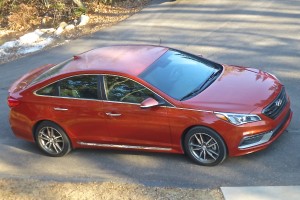 But the new Sonata, which starts with the same reliable and peppy 2.4-liter 4 standard, adds a couple of variants for 2015. A Sport version has the reduced-displacement 2.0-liter engine, which is turbocharged and direct-injected for a large boost in power, and the 6-speed automatic gets steering-wheel paddle controls for manual shifting. The steering wheel has a flat-bottom shape, similar to the Volkswagen Golf GTI, for those who might not push the Sonata Sport hard enough to appreciate its improved dynamics.
But the new Sonata, which starts with the same reliable and peppy 2.4-liter 4 standard, adds a couple of variants for 2015. A Sport version has the reduced-displacement 2.0-liter engine, which is turbocharged and direct-injected for a large boost in power, and the 6-speed automatic gets steering-wheel paddle controls for manual shifting. The steering wheel has a flat-bottom shape, similar to the Volkswagen Golf GTI, for those who might not push the Sonata Sport hard enough to appreciate its improved dynamics.
In addition, the Sonata is offered with Hyundai’s very peppy little 1.6-liter 4, lifted from the Accent, Elantra, and even the newly revised Tucson SUV in a hyper-economy model. Turbocharging makes it more than just an economy car. In a matter of weeks, Hyundai also will present a new hybrid Sonata.
After driving several models at the Sonata introduction, I spent a week with a glistening white Sonata Limited, and more recently was able to spend a week with a Sonata Sport. It was a unique off-red color, called “urban sunset,” and it came with the 2.0 turbocharged engine that produces 245 horsepower at 6,000 RPMs, and 260 foot-pounds of torque, which is not only a lot of punch, but peaks and remains constant all the way from 1,350 to 4,000 RPMs.
The car carved through curves and tight corners with precision, amplified by the paddle-shifting, which gives the Sonata part of its new personality. Greatly appreciated, too, is the coordination between the refined power steering and the new suspension — both tweaked to sport settings.
With stability management and traction control, the latest brake-force distribution and brake assist, plus all the high-tech features, such as blind-spot detection, rear cross-traffic alert, leather seats, automatically dimming rearview mirror, and Bluetooth and Blue Link connectivity, the Sonata Sport listed at $29,510. Definitely a bargain, considering the features and refinement contained within.
“More horizontal architectural lines create the reality of more control,” said Chapman, inadvertently describing the juncture of appearance with reality. “It’s built with safety, but it’s intuitive and comfortable while being safe. If we can turn safety into something sexy, the whole industry will be better off.”
Hard to quarrel with that. It’s all part of living up to its new image, although the explanation, impressive as it is, might still fall short of explaining how the previous generation Sonata had all the ingredients to be a great car, while the new one puts all those ingredients in place to reach that plateau of being a truly great car.



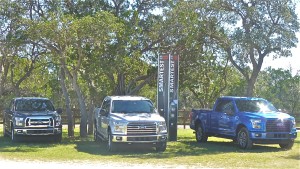

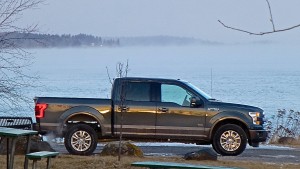
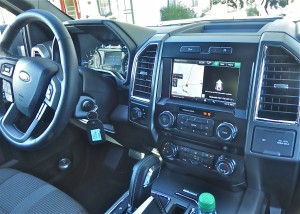

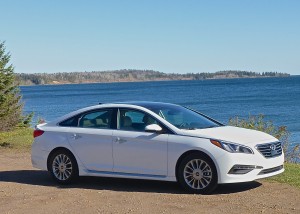
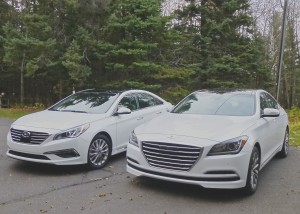
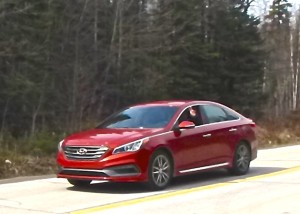
 John Gilbert is a lifetime Minnesotan and career journalist, specializing in cars and sports during and since spending 30 years at the Minneapolis Tribune, now the Star Tribune. More recently, he has continued translating the high-tech world of autos and sharing his passionate insights as a freelance writer/photographer/broadcaster. A member of the prestigious North American Car and Truck of the Year jury since 1993. John can be heard Monday-Friday from 9-11am on 610 KDAL(www.kdal610.com) on the "John Gilbert Show," and writes a column in the Duluth Reader.
John Gilbert is a lifetime Minnesotan and career journalist, specializing in cars and sports during and since spending 30 years at the Minneapolis Tribune, now the Star Tribune. More recently, he has continued translating the high-tech world of autos and sharing his passionate insights as a freelance writer/photographer/broadcaster. A member of the prestigious North American Car and Truck of the Year jury since 1993. John can be heard Monday-Friday from 9-11am on 610 KDAL(www.kdal610.com) on the "John Gilbert Show," and writes a column in the Duluth Reader.